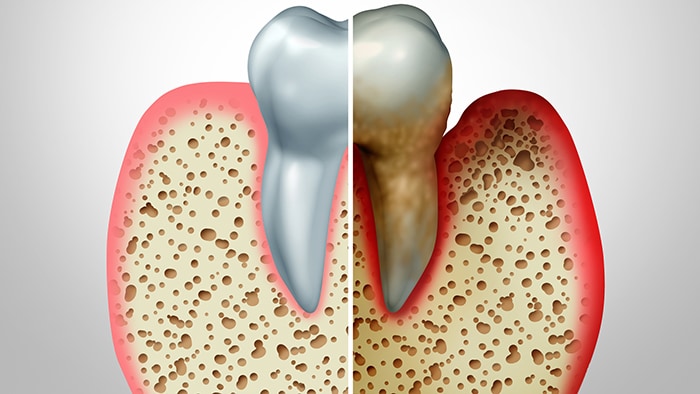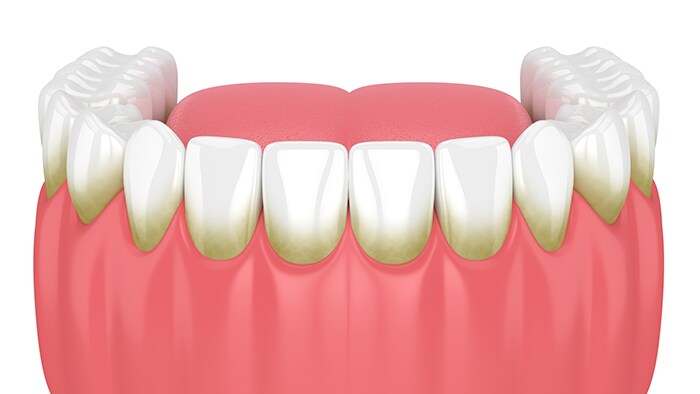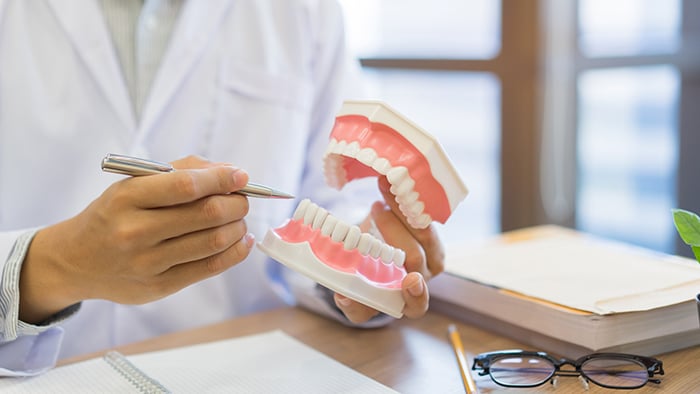What is Periodontitis and How to Treat It
What is Periodontitis?
Periodontitis is commonly known as gum disease and it’s a serious infection that affects the mouth.
What are the symptoms of periodontitis?
The first symptom you would notice of periodontitis or gum disease is swollen or puffy gums. Your gums might also look redder than they normally do. Gum disease also causes gums to feel tender and painful when touched. Your gums may even recede or pull away from the teeth. Periodontitis-inflicted gums often bleed easily when you brush your teeth or floss. If you ever spit out blood while performing standard oral care, that could be cause for alarm. Bad breath can even be a symptom of gum disease. If you notice bad breath even when you’re properly caring for your teeth and mouth, it could by a periodontitis symptom. Periodontitis can cause pus between your teeth and gums, new spaces appearing between your teeth, your teeth feeling as if they fit differently together as you bite down, and painful chewing. Severe cases can even cause loss of teeth.
What are the stages of periodontitis?
You might be considering gingivitis vs periodontitis and what the differences between the two diseases are. Periodontitis is actually a disease with several stages, and gingivitis is one of those stages.

Stage one: gingivitis
The first stage of periodontitis is gingivitis. If you catch your gum disease at this stage you’re in luck because all the effects are still reversible. At the gingivitis stage, the gum disease hasn’t damaged your bones. The symptoms to look for at this stage are occasional bad breath, gum swelling, and bleeding when flossing and brushing. These can be hard to spot, so it’s important to stay vigilant and regularly visit your dental professional for check-ups. A lot of the more obvious symptoms appear when the disease has progressed further.
Stage two: slight/early periodontal disease
At this point, gum disease may have caused lasting damage, but that doesn’t mean it can’t still be treated and further damage prevented. Stage two is defined by the progression of the infection—once it has reached your bones and begun to attack them. The infection gains access to your bones by causing the gums to recede and expose the bones. Symptoms to spot at this point are swelled and red gums, bad breath, bleeding when brushing and flossing, receded gums, and painful gums. If you exhibit stage two symptoms you will need to see a dental professional to address the issue. If you think you might be exhibiting symptoms but you’re not sure, it’s best to visit your dental professional so they can properly advise you.
Stage three: moderate periodontal disease
At stage three, the disease is attacking your teeth. This can cause your teeth to feel loose in your jaws. The disease also spreads beyond the bones at stage three and attacks the blood stream and immune system as well. Scaling and root planing are forms of deep cleaning that your dentist can do to remove the harmful bacteria that’s deep in the gums.
What you need

Philips Sonicare Cordless Power Flosser 3000 Oral Irrigator
HX3806/31
Flossing reinvented with QuadStream technology
Effortlessly thorough cleaning between teeth to improve your gum health. Unique Quad Stream tip cleans more area with less effort for more effective flossing every time, so it's easy to get flossing right.
See all benefitsUnfortunately this product is no longer available
Stage four: advanced periodontal disease
The most extreme stage of gum disease occurs when the infection deepens again. The disease-causing bacteria is deep in the gums and causing serious damage. Tooth and bone loss is a serious and likely outcome of extreme gum disease. Red and swollen gums, pus, cold sensitivity, more loose teeth, painful chewing, and extreme bad breath or halitosis are all common symptoms at this stage. Stage four periodontal disease requires surgery to address the issue.

What causes periodontitis?
Our mouths are breeding grounds for bacteria, which is why proper oral care is so important. Bacteria exists in our saliva, in food, and could be on anything we put in our mouths. Bacteria will grow on our teeth and cause a lot of problems for us, including gum disease or periodontitis. Periodontitis is a bacterial infection that starts when plaque is left for too long on the teeth. This plaque can cause inflammation in and around the gums. Then it forces the gums to pull back from the teeth to expose the bone beneath. Plaque is the biggest antagonist of proper oral health and can cause a lot of problems. Even a lot of bad breath can be traced to plaque. When we let plaque sit on our teeth and in our mouths, we let it cause problems for us in the future.
What’s the best periodontitis treatment?
How to go about treating gum disease will depend on how severe the case is. In milder cases (stage one), professional dental cleaning can remove all excess plaque and tartar from your teeth. With all the nasty stuff removed, your mouth has a fresh start. In more extreme cases (stages two and three), you may need scaling and root planing, which removes plaque from beneath the gum line. In severe cases (stage four), your teeth may require surgical treatment and laser therapy. This is the only way to remove the deeply nested bacteria that forms when the disease progresses. The best way to treat periodontitis is to avoid getting it in the first place, with proper prevention methods.

How to prevent periodontitis?
Whenever you’re looking to prevent any oral health issue, proper oral care is the best and easiest method. Brushing your teeth twice a day and flossing once a day is the best defence against periodontitis as well as bad breath, stained teeth, and any other oral hygiene problem. Switching to an electric toothbrush could help you maintain better oral hygiene, as they perform better than manual toothbrushes. Remember to brush all the way onto your gum line, where the gum and teeth meet. This removes that dangerous plaque from your gums as well as your teeth. Electric flossing can also help you achieve optimal oral hygiene. Manual flossing with traditional string floss can be particularly difficult when trying to floss those hard-to-reach teeth further into your mouth.
Recommended electric toothbrushes to prevent periodontitis
The Sonicare Power Flosser removes up to 99.9% of plaque with its powerful yet gentle bursts of air and water. For toothbrush options, the Philips Sonicare DiamondClean smart toothbrush uses five unique brushing options. an intuitive pressure sensor, and advanced brush head technology to deliver exceptional plaque removal and improved gum health. It also comes with an app so you get science backed personalised oral care. For more sensitive gums, the Philips Sonicare ProtectiveClean offers an exceptional clean with a more gentle approach and a built in pressure sensor.











